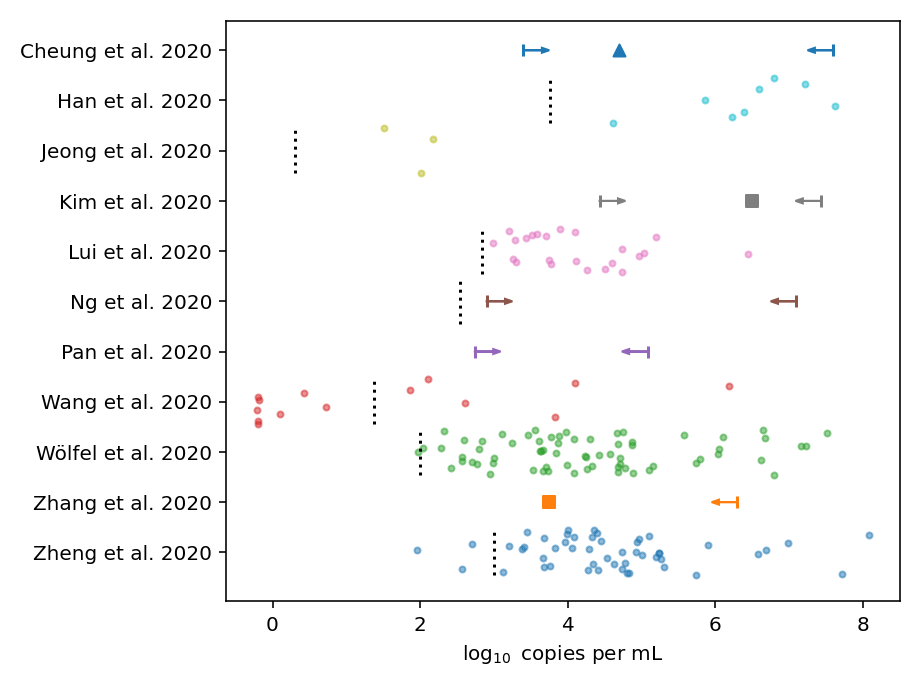💩 Shedding of SARS-CoV-2 RNA in faeces¶

Uncertainties surrounding the concentration of viral RNA fragments in the faeces of individuals infected with SARS-CoV-2 poses a major challenge for wastewater-based surveillance of Covid-19. This repository serves to collate data from quantitative studies on RNA load in faecal samples to constrain the shedding distribution.
📊 Datasets¶
Datasets can be found in the publications directory as JSON files following a common schema (see schema.json for details). All RNA loads are reported as log10 gene copies per mL. The results from individual samples are linked to patients wherever possible to provide longitudional information.
Key |
Assay |
LOQ |
Patients |
Samples |
Detailed data |
Temporal data |
||||
|---|---|---|---|---|---|---|---|---|---|---|
n |
+ |
- |
n |
+ |
- |
|||||
? |
? |
59 |
9 (15.3%) |
50 (84.7%) |
? |
? |
? |
- |
- |
|
PowerChek-E |
3.76 |
2 |
2 (100.0%) |
0 (0.0%) |
9 |
8 |
1 |
+ |
symptoms |
|
S |
0.30 |
5 |
3 (60.0%) |
2 (40.0%) |
5 |
3 |
2 |
+ |
symptoms |
|
RdRp_SARSr |
? |
38 |
8 (21.1%) |
30 (78.9%) |
129 |
13 |
116 |
- |
- |
|
2019-nCoV_N1 |
2.84 |
11 |
11 (100.0%) |
0 (0.0%) |
43 |
23 |
20 |
+ |
symptoms |
|
2019-nCoV_N1 |
2.54 |
21 |
21 (100.0%) |
0 (0.0%) |
81 |
? |
? |
- |
- |
|
HKU-N |
? |
17 |
9 (52.9%) |
8 (47.1%) |
? |
? |
? |
- |
- |
|
CCDC-ORF1ab |
1.38 |
14 |
6 (42.9%) |
8 (57.1%) |
14 |
6 |
8 |
+ |
- |
|
RdRp_SARSr, E_Sarbeco |
2.00 |
9 |
8 (88.9%) |
1 (11.1%) |
82 |
68 |
14 |
+ |
symptoms |
|
ORF1ab |
? |
12 |
10 (83.3%) |
2 (16.7%) |
51 |
? |
? |
- |
- |
|
ORF1ab |
3.00 |
85 |
50 (58.8%) |
35 (41.2%) |
842 |
? |
? |
+ |
- |
|
(Source code, png)

Overview of viral RNA load data available in different publications. Black vertical dotted lines represent the level of quantification or threshold for a sample to be considered positive. Arrows represent limits of viral RNA load reported in some studies. Squares and triangles represent the mean and median, respectively.¶
🤝 Contributing¶
Contributions in the form of new datasets or corrections are most welcome in the form of pull requests from forks. See here for more details on how to contribute.
🧪 Reproducing results¶
Results can be reproduced by following these steps:
Make sure you have python 3.8 or newer installed.
Install the python dependencies by running
pip install -r requirements.txt(ideally in a dedicated virtual environment).Install the polychord sampler by running
make pypolychord(you may have to runmake pypolychordtwice if it fails in the first run).Reproduce the figures (in the
workspace/figuresdirectory) and results (in theresults.htmlfile) by runningmake workspace/results.html.
If you are familiar with docker, you may also reproduce results in a container by following these steps:
Run
make imageto build the docker image.Run
make containerto start a container with theworkspacefolder mounted.Reproduce the figures (in the
workspace/figuresdirectory) and results (in theresults.htmlfile) by runningmake workspace/results.html.
Note
Reproducing the results will take a considerable amount of time (several hours if you have a fast machine, days if you have a slow machine). You have two options to speed up the process (and they can be combined).
Use
make -j [number of processors you use] results.htmlwhich will distribute the workload across the given number of processors.Use
SEEDS=0 NLIVE=1 NREPEAT=1 make results.htmlwhich will only run the inference for one random number generator seed and use fewer points for the nested sampling (giving rise to less reliably but faster results).
Note
Storing intermediate results produced by pypolychord can take up to 10GB of disk space.
If you are not able to reproduce the results using the steps above, try running make tests which may help identify the problem. Otherwise, please raise a new issue.
📋 Contents¶
- shedding python package
- Gastrointestinal Manifestations of SARS-CoV-2 Infection and Virus Load in Fecal Samples From a Hong Kong Cohort: Systematic Review and Meta-analysis
- Sequential Analysis of Viral Load in a Neonate and Her Mother Infected With Severe Acute Respiratory Syndrome Coronavirus 2
- Viable SARS-CoV-2 in various specimens from COVID-19 patients
- Detection and Isolation of SARS-CoV-2 in Serum, Urine, and Stool Specimens of COVID-19 Patients from the Republic of Korea
- Viral dynamics of SARS-CoV-2 across a spectrum of disease severity in COVID-19
- Screening FMT donors during the COVID-19 pandemic: a protocol for stool SARS-CoV-2 viral quantification
- Viral load of SARS-CoV-2 in clinical samples
- Detection of SARS-CoV-2 in Different Types of Clinical Specimens
- Virological assessment of hospitalized patients with COVID-2019
- Comparative study on virus shedding patterns in nasopharyngeal and fecal specimens of COVID-19 patients
- Viral load dynamics and disease severity in patients infected with SARS-CoV-2 in Zhejiang province, China, January-March 2020: retrospective cohort study